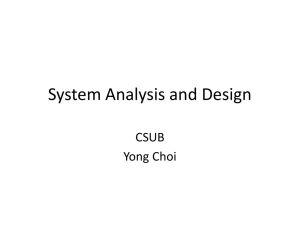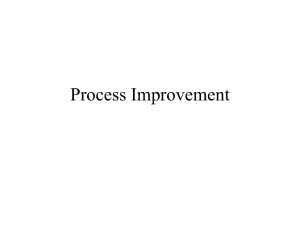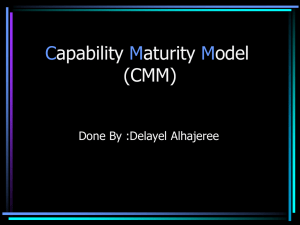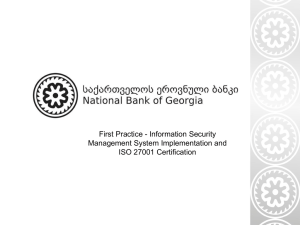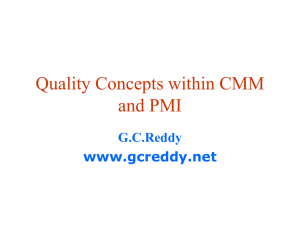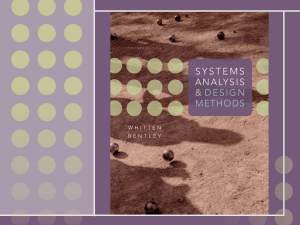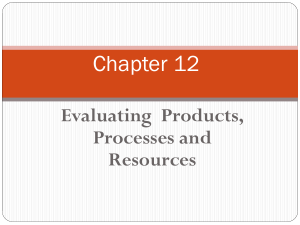Amoco: Introduction to the SEI`s CMM
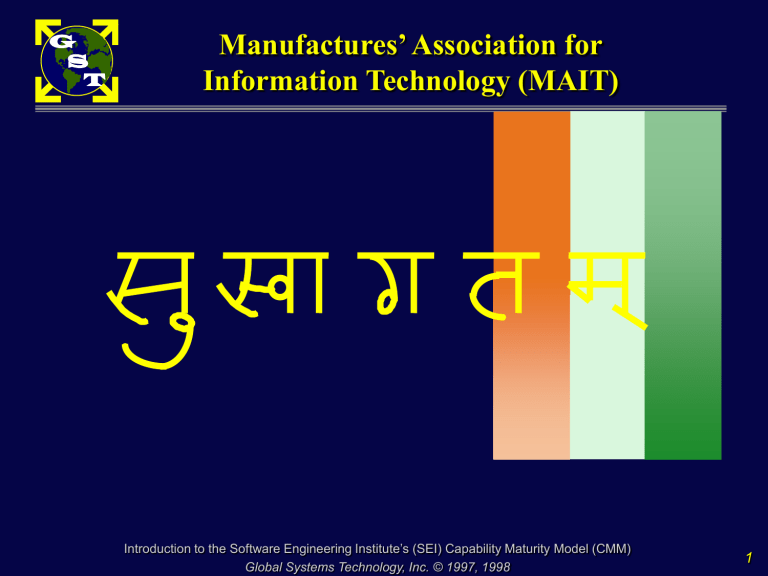
G
S
T
Manufactures’ Association for
Information Technology (MAIT)
Introduction to the Software Engineering Institute’s (SEI) Capability Maturity Model (CMM)
Global Systems Technology, Inc. © 1997, 1998
1
G
S
T
Global Systems Technology, Inc.
Introduction to the
Software Engineering Institute’s (SEI)
Capability Maturity Model (CMM)
“Improving
what
you build means improving
how
you build”
The SEI is a Federally Funded Research and Development Center Located at
Carnegie Mellon University in Pittsburgh, Pennsylvania
Introduction to the Software Engineering Institute’s (SEI) Capability Maturity Model (CMM)
Global Systems Technology, Inc. © 1997, 1998
2
G
S
T
Global Systems Technology, Inc.
Course Overview
Introduction: An Executive Overview of the CMM (6 Hrs)
Level 2: Understanding the Repeatable Level KPAs (5 Hrs)
Level 3: Understanding the Defined Level KPAs (6 Hrs)
Level 4: Understanding the Managed Level KPAs (2 Hrs)
Level 5: Understanding the Optimizing Level KPAs (3 Hrs)
CMM Summary and Test (2 Hrs)
Introduction to the Software Engineering Institute’s (SEI) Capability Maturity Model (CMM)
Global Systems Technology, Inc. © 1997, 1998
3
G
S
T
Global Systems Technology, Inc.
Course Guidelines
The Class schedule will be followed.
The Class will start at 9:30 and end at 5:30 promptly.
One break in the morning, one in the afternoon.
Course is fast paced, but questions are welcome.
Exercises and test will be given, and results provided to
SEI CMM site training coordinator.
Introduction to the Software Engineering Institute’s (SEI) Capability Maturity Model (CMM)
Global Systems Technology, Inc. © 1997, 1998
4
G
S
T
Global Systems Technology, Inc.
Day
1
Executive
Overview
Course Schedule
Morning Afternoon
Executive
Overview
Executive
Overview
APA
Level 2 Level 3 Level 3 Level 3
Day
2
Level 4 Level 4/5 Level 5
Summary
And Test
Day
3
Introduction to the Software Engineering Institute’s (SEI) Capability Maturity Model (CMM)
Global Systems Technology, Inc. © 1997, 1998
5
G
S
T
Global Systems Technology, Inc.
Day One: Executive Overview
Understand the origins of the CMM and the underlying need
Understand the difference between the CMM and ISO 9000
Recognize the Benefits of CMM based software process improvements
Be able to describe the CMM and how it is organized
Understand management’s commitments in CMM based software process Improvement
Be able to describe the CMM and how it is organized
Understand the elements necessary for successful software process improvement
Results of the Abbreviated Process Assessment
Introduction to the Software Engineering Institute’s (SEI) Capability Maturity Model (CMM)
Global Systems Technology, Inc. © 1997, 1998
6
G
S
T
Global Systems Technology, Inc.
Evolution of the CMM
For Software
Introduction to the Software Engineering Institute’s (SEI) Capability Maturity Model (CMM)
Global Systems Technology, Inc. © 1997, 1998
7
G
S
T
Global Systems Technology, Inc.
Cobb’s Paradox
“We know why projects fail, we know how to prevent their failure....so why do they still fail?”
Martin Cobb
Treasury Board of Canada Secretariat
Ottawa, Canada
Introduction to the Software Engineering Institute’s (SEI) Capability Maturity Model (CMM)
Global Systems Technology, Inc. © 1997, 1998
8
G
S
T
Global Systems Technology, Inc.
The Need for Better Planning and Managing
For every 100 IT projects started, 94 are “restarted”
Average IT project cost overrun is 178% in large companies
Average IT project time overrun is 230% in large companies
42% of original features proposed of IT projects in large companies actually get ported in the final product
This information and the following statistics are the result of an extensive national (United States) survey conducted by the Standish Group.
Respondents were IT Executives.
Introduction to the Software Engineering Institute’s (SEI) Capability Maturity Model (CMM)
Global Systems Technology, Inc. © 1997, 1998
9
G
S
T
Global Systems Technology, Inc.
Project Success Profiles
The reasons projects succeed:
• User Involvement
• Executive Management Support (Active interest)
• Clear Statement of Requirements
• Proper Planning
• Realistic Expectations
• Smaller Project Milestones (Visibility)
• Competent Staff
• Ownership
• Clear Vision and Objectives
• Risk Planning, Identification and Mitigation
Introduction to the Software Engineering Institute’s (SEI) Capability Maturity Model (CMM)
Global Systems Technology, Inc. © 1997, 1998
10
G
S
T
Global Systems Technology, Inc.
Project Obstacles Profiles
The reasons projects are challenged:
• Lack of User Input
• Incomplete Requirements and Specifications
• Changing Requirements and Specifications
• Lack of Executive Support
• Technical Incompetence
• Lack of Resources
• Unrealistic Expectations
• Unclear Objectives
• New Technology
• Team Commitment
Introduction to the Software Engineering Institute’s (SEI) Capability Maturity Model (CMM)
Global Systems Technology, Inc. © 1997, 1998
11
G
S
T
Global Systems Technology, Inc.
Project Failure Profiles
The reasons projects are impaired and canceled:
Incomplete Requirements
Lack of User Involvement
Lack of Resources
Unrealistic Expectations
Lack of Executive Support
Changing Requirements
Lack of Planning
Obsolete before it is complete
Lack of IT Management
Oversight
Technology Illiteracy
Does not solve business problem
Unrealistic schedule requirements
Lack of Program
Management training
Poor Estimating
Introduction to the Software Engineering Institute’s (SEI) Capability Maturity Model (CMM)
Global Systems Technology, Inc. © 1997, 1998
12
G
S
T
Global Systems Technology, Inc.
Industry IT Project Facts: 1995
31.1 % of all projects were canceled before they are completed.
52.7% of projects cost 189% of their original estimates
The cost for IT projects in American Companies and in the government that were canceled before implementation in 1995 is estimated at $81 billion dollars.
The cost of overruns for the same period (in addition to canceled projects) is estimated at $59 billion .
Introduction to the Software Engineering Institute’s (SEI) Capability Maturity Model (CMM)
Global Systems Technology, Inc. © 1997, 1998
13
G
S
T
Global Systems Technology, Inc.
More Industry Project Facts
Lost opportunities cost is not measurable, but could be in the trillions of dollars. Remember Denver; the cost of not having the baggage system working was costing the City of Denver
$1.1 million dollars a day.
Only 9% of projects in large companies come in on budget and on schedule.
Introduction to the Software Engineering Institute’s (SEI) Capability Maturity Model (CMM)
Global Systems Technology, Inc. © 1997, 1998
14
G
S
T
Global Systems Technology, Inc.
Industry Project Success Criteria
SUCCESS CRITERIA POINTS
•
•
•
•
• User Involvement
• Executive Management Support
• Clear Statement of Requirements
• Proper Planning
Realistic Expectations
• Smaller Project Involvement
• Competent Staff
Ownership
Clear Vision and Objectives
Hard-Working and Focused Staff
19
16
15
11
10
09
08
06
03
03
100
Introduction to the Software Engineering Institute’s (SEI) Capability Maturity Model (CMM)
Global Systems Technology, Inc. © 1997, 1998
15
G
S
T
Global Systems Technology, Inc.
Evolution of the CMM
Conditions described were worse in the 1960s and 1970s.
GAO (US Government Accounting Office) study in 1983 showed that only 3% of the software being delivered to the Government was usable on delivery; that 49% was never usable; and that
48% needed modification prior to use.
In the early 1980s, the Government created a Federally Funded
Research and Development Center at Carnegie Mellon
University, The Software Engineering Institute.
Objective was to reduce the Government’s exposure to software development and maintenance risk.
TQM was in full swing in the manufacturing environment.
Introduction to the Software Engineering Institute’s (SEI) Capability Maturity Model (CMM)
Global Systems Technology, Inc. © 1997, 1998
16
G
S
T
Global Systems Technology, Inc.
Evolution of the CMM
S/W Engineering Sciences
TQM PRINCIPLES
Maturing 1940s-1980s
DOD Standards Development: Mil-S-482, 483, 1679,
2167, 498 (Also: 52779, 2168)
Commercial Standards: IEEE 498, 12207
ISO Standards: 12207
Commercial Practices of S/W Organizations
ISO 9000 Series (Commercial)
ASQC Tech-notes
DOD Standards (Mil Q 9858A)
SHEWART (1920s)
DEMMING (1950s)
ISHIKAWA (1940s)
JURAN (1960s)
CROSBY(1970s)
ADAPTATION OF
QUALITY
MANAGEMENT
MATURITY GRID
TO SOFTWARE
DOMAIN
DEFINITION OF
THE FIVE LEVELS
OF SOFTWARE
PROCESS
MATURITY IN THE
CMM
FRAMEWORK
SEI/1987-1993
QUALITY
MANAGEMENT
MATURITY GRID
P. CROSBY/1979
W. HUMPHREY
IBM/1985
Introduction to the Software Engineering Institute’s (SEI) Capability Maturity Model (CMM)
Global Systems Technology, Inc. © 1997, 1998
CMM
For
Software
(Model)
17
G
S
T
Global Systems Technology, Inc.
Evolution of the CMM
SEI, formed in 1984, began an examination of organizations that were recognized for producing high quality software products that were delivered on-time and within budget.
Approximately 87 organizations were identified and examined, some of which were excluded from the study.
The processes used by the remaining organizations were examined and the most common practices were then cataloged as the Key Practices and grouped into Key Process Areas (KPAs).
The KPAs were grouped into levels of capability. The maturity levels were derived from TQM literature and applied to software.
Introduction to the Software Engineering Institute’s (SEI) Capability Maturity Model (CMM)
Global Systems Technology, Inc. © 1997, 1998
18
G
S
T
Global Systems Technology, Inc.
Evolution of the CMM
The organizations had applied their good business practices to the development of software.
The KPAs, in aggregate, represent “good business” practices that have been defined in the context of a software development environment.
Introduction to the Software Engineering Institute’s (SEI) Capability Maturity Model (CMM)
Global Systems Technology, Inc. © 1997, 1998
19
G
S
T
Global Systems Technology, Inc.
Definition of Software Process
Procedures and methods defining the relationship of tasks
Process
People with skills, training and motivation
Tools and equipment
Introduction to the Software Engineering Institute’s (SEI) Capability Maturity Model (CMM)
Global Systems Technology, Inc. © 1997, 1998
20
G
S
T
Global Systems Technology, Inc.
TQM CMM
Assumes processes are mature
Expects processes to be institutionalized
Expects processes to be immature
Recognizes the benefit of quantitative measures in process management and change
Builds foundation so
TQM can be applied
Introduction to the Software Engineering Institute’s (SEI) Capability Maturity Model (CMM)
Global Systems Technology, Inc. © 1997, 1998
21
G
S
T
Global Systems Technology, Inc.
Applying TQM to Software
Organization
TQM
Project A Project B
Project C
Software
Hardware
Project D
The CMM is a model for software process that embodies the principles of TQM
System
CMM
TQM fits in an overall business context - the Capability Maturity
Model (CMM) applies specifically to software.
Introduction to the Software Engineering Institute’s (SEI) Capability Maturity Model (CMM)
Global Systems Technology, Inc. © 1997, 1998
22
G
S
T
Global Systems Technology, Inc.
Points in Common with the Quality Movement
Improvement focuses on fixing the process, not on blaming the people.
Improvement must be measured and periodically reinforced
Improvement requires consistency of investment, training and effort to search for new opportunities to improve
Improvement is a continuous process.
If level of discomfort is not high enough (i.e., market share, time-to-market, competitive posture, number of fielded defects, etc., are acceptable to the organization) things will not change.
Introduction to the Software Engineering Institute’s (SEI) Capability Maturity Model (CMM)
Global Systems Technology, Inc. © 1997, 1998
23
G
S
T
Global Systems Technology, Inc.
How Does Your Customer Benefit?
Confidence in you, the product/service provider
On-time delivery of your products and services
Reduced costs of your software development activities
Acceleration of your work accomplishments
Improvement in your product service quality
Ability to better plan their business activities due to the overall reduced risk in doing business with
Introduction to the Software Engineering Institute’s (SEI) Capability Maturity Model (CMM)
Global Systems Technology, Inc. © 1997, 1998
24
G
S
T
Global Systems Technology, Inc.
What’s in it for the Employee
?
Less overtime required to get the job done
Improved customer relations and customer satisfaction
Enhanced “team” working environment within the organization, where you can depend on everyone
Improved personal performance as you have a shorter learning curve, can benefit from others’ experiences
Enhanced professional skills, defined methods and processes, and availability of training
Introduction to the Software Engineering Institute’s (SEI) Capability Maturity Model (CMM)
Global Systems Technology, Inc. © 1997, 1998
25
G
S
T
Global Systems Technology, Inc.
How Does the Organization Benefit?
Improved customer relations results in additional work, and better communications
Recognition of products from customers
Satisfied employees resulting in best efforts and retention
Better response and less business risk in meeting client needs
Improved quality and productivity of services and products provided resulting in improved competitiveness, market share increase
Increased Market Share! Increased Efficiency! Improved Profitability!
Introduction to the Software Engineering Institute’s (SEI) Capability Maturity Model (CMM)
Global Systems Technology, Inc. © 1997, 1998
26
G
S
T
Global Systems Technology, Inc.
Quality
Benefits of Using CMM Model
Productivity
52% Decrease in
Product Errors
CMM Level
......1..... .....2..... .....3..... .....4..... .....5.....
Time to Market
34% Decrease in
Cost to Develop
CMM Level
......1..... .....2..... .....3..... .....4..... .....5.....
Risk
15% Decrease in
Time to Deliver
Significant Reduction in Development Risk
CMM Level
......1..... .....2..... .....3..... .....4..... .....5.....
CMM Level
......1..... .....2..... .....3..... .....4..... .....5.....
Introduction to the Software Engineering Institute’s (SEI) Capability Maturity Model (CMM)
Global Systems Technology, Inc. © 1997, 1998
27
G
S
T
Global Systems Technology, Inc.
Improvement
Category
Improvements Using the CMM
Measurement
Cost
Sc hed ule
O ther
1 .
Defe cts
2 .
Error Rate
3 .
Pro duc t
4 .
Error
5 .
$ Save d
6 .
Cos ts
7 .
Savi ngs
8 .
ng s
9 .
Wi thi n
1 0 .
me De liv ery
1 1 .
Proj e c
1 2 .
Sa v i
50% Aver age
45% Aver age
KSL OC
80% Sa vin gs
50%
+ or – 5% Ave rag e
15% Aver age
1 3 .
Rework
1 4 .
Sa v i
Introduction to the Software Engineering Institute’s (SEI) Capability Maturity Model (CMM)
Global Systems Technology, Inc. © 1997, 1998
28
G
S
T
Global Systems Technology, Inc.
Maturity Levels in Review (Predictability)
Level Characteristics Predicted Performance
Optimizing
4
5
Managed
Process Improvement is institutionalized
Product and process are quantitatively controlled
Quality/Schedule/Cost
Quality/Schedule/Cost
2
1
Software engineering and management processes defined and integrated
Project management system in place; performance is repeatable
Process is informal and ad hoc; performance is unpredictable
Quality/Schedule/Cost
Quality/Schedule/Cost
Quality/Schedule/Cost
Introduction to the Software Engineering Institute’s (SEI) Capability Maturity Model (CMM)
Global Systems Technology, Inc. © 1997, 1998
29
4
3
2
G
S
T
Global Systems Technology, Inc.
Maturity Levels In Review (Visibility)
1
Introduction to the Software Engineering Institute’s (SEI) Capability Maturity Model (CMM)
Global Systems Technology, Inc. © 1997, 1998
30
G
S
T
Global Systems Technology, Inc.
Maturity Levels In Review (Visibility)
5
Introduction to the Software Engineering Institute’s (SEI) Capability Maturity Model (CMM)
Global Systems Technology, Inc. © 1997, 1998
31
G
S
T
Global Systems Technology, Inc.
What Are the
Risks
of Model-Based
Improvements?
Models are simplifications of the real world
Models are not comprehensive
Interpretation and tailoring must be aligned to business objectives
Judgment is necessary to use models correctly and with insight
Introduction to the Software Engineering Institute’s (SEI) Capability Maturity Model (CMM)
Global Systems Technology, Inc. © 1997, 1998
32
G
S
T
Global Systems Technology, Inc.
What the CMM Does Not Cover
The CMM does not address all software process and quality improvement issues.
Not included:
• User Needs
Analysis
• Requirements
Definition
• System
Requirements
• System Design
• Risk
Management
The CMM focuses on Software
Engineering through:
Software Requirements
Software Design
Code and Unit Test
Integration Test
Software Test
Not included:
• Systems Testing
• Implementation
Support
• Customer
Support
• User Training
Introduction to the Software Engineering Institute’s (SEI) Capability Maturity Model (CMM)
Global Systems Technology, Inc. © 1997, 1998
33
G
S
T
Global Systems Technology, Inc.
The CMM Focuses on Software
Development Issues
Issues addressed only indirectly, or by implication, include:
• specific tools, methods, and technologies
• concurrent engineering, Joint Application Development and teamwork
• system engineering, marketing, testing, delivery
• human resources
• organizational behavior
Introduction to the Software Engineering Institute’s (SEI) Capability Maturity Model (CMM)
Global Systems Technology, Inc. © 1997, 1998
34
G
S
T
Capability Versus Performance
Process capability - the range of expected results that can be achieved by following a process, initially established at the organization level. A predictor of future project outcomes.
Process performance - a measure of the actual results achieved from following a process. Refers to a particular project in the organization
Introduction to the Software Engineering Institute’s (SEI) Capability Maturity Model (CMM)
Global Systems Technology, Inc. © 1997, 1998
35
G
S
T
Global Systems Technology, Inc.
But I have ISO, so why do I need the CMM?
“In today’s competitive marketplace, ISO 9000 registration is becoming a requirement for doing business in many industries. To remain competitive, companies need to go beyond that.” Quality Digest
The CMM practices focuses on competitiveness and emphasize the business objectives, bottom line performance, employee satisfaction and development, and supplier and partner performance.
Introduction to the Software Engineering Institute’s (SEI) Capability Maturity Model (CMM)
Global Systems Technology, Inc. © 1997, 1998
36
G
S
T
Global Systems Technology, Inc.
How ISO and the CMM Differ
ISO
Prescriptive
Standard - Organizations must comply
Identifies what “must” be done and by whom
Looks at process existence, execution not at
“goodness”
Requires process improvement activities
Focused on Quality
Management System
CMM
Descriptive
Model - Must be tailored to organization’s business environment
Describes successful software development practices
Expects processes to “make sense” to organization
Focused process improvement of business practices
Requires tailoring of process to project needs
Introduction to the Software Engineering Institute’s (SEI) Capability Maturity Model (CMM)
Global Systems Technology, Inc. © 1997, 1998
37
G
S
T
Global Systems Technology, Inc.
How ISO and the CMM Differ
RM SPP SPTO SSM SQA SCM OPF OPD TP ISM SPE IC PR QPM SQM DP TCM PCM Coverage
AREAS
10%
AREAS COVERED BY
ISO 9001/9000-3
PARTIALLY
COVERED
20%
30%
40%
50%
60%
70%
80%
AREAS NOT COVERED BY
ISO 9001/9000-3
90%
100%
Introduction to the Software Engineering Institute’s (SEI) Capability Maturity Model (CMM)
Global Systems Technology, Inc. © 1997, 1998
38
G
S
T
Global Systems Technology, Inc.
(After ISO)
ISO and the CMM share the same
Organizational constraints,
Both must be adapted to those constraints.
Enterprise
(Before ISO)
ISO, as a standard, requires the
Organization to conform. The
Organization may need to expand activities to cover the ISO requirements.
(After CMM)
CMM for Software
Coverage and
Applicability
CMM , as a model, is used to understand and evolve within the
Organization constraints. Blind compliance without a reasonable interpretation and use of professional judgement may mislead the Organization.
ISO 9000
(9000-3)
Coverage and
Applicability
Introduction to the Software Engineering Institute’s (SEI) Capability Maturity Model (CMM)
Global Systems Technology, Inc. © 1997, 1998
39
G
S
T
Global Systems Technology, Inc.
Models are simplified views of the real world
THE REAL WORLD
Integrated Product Teams
Organization Culture
System Engineering
People Issues
Technology
Marketing
Procedures, templates, models, tool usage, and forms, are below the level of detail within the
CMM
The capability maturity model for software
Introduction to the Software Engineering Institute’s (SEI) Capability Maturity Model (CMM)
Global Systems Technology, Inc. © 1997, 1998
40
G
S
T
Global Systems Technology, Inc.
So, What is the CMM?
The CMM is a model that describes software development practices that are recognized as critical to success for software development efforts within state of the practice organizations.
The CMM describes “what” activities are necessary for success.
(It is Descriptive)
The CMM does not describe “how” the activities are to be performed. (It is Not Prescriptive)
Your organization procedures (QMS) describes how activities are to be performed.
Introduction to the Software Engineering Institute’s (SEI) Capability Maturity Model (CMM)
Global Systems Technology, Inc. © 1997, 1998
41
G
S
T
Global Systems Technology, Inc.
Common Sense Issues
The CMM is a model.
A reasonable interpretation of the CMM practices and professional judgment in application is necessary.
The CMM was written to address the process for large, complex software efforts.
Early efforts in tailoring the CMM indicate that in excess of 90% of key practices are applicable as written when interpreted in the context of the specific applications for both large and small organizations.
Introduction to the Software Engineering Institute’s (SEI) Capability Maturity Model (CMM)
Global Systems Technology, Inc. © 1997, 1998
42
G
S
T
Global Systems Technology, Inc.
The Model:
SEI’s CMM
Understanding the model structure
Introduction to the Software Engineering Institute’s (SEI) Capability Maturity Model (CMM)
Global Systems Technology, Inc. © 1997, 1998
43
G
S
T
Global Systems Technology, Inc.
Maturity Levels Provide an Orderly Path for SPI
Process capability is built in stages
• This does not imply a ladder - some processes are ineffective when others are not stable
Each level provides a foundation for improvements at the next level
• engineering process is easily sacrificed without management discipline
• detailed measures are inconsistent without a defined process
• effect of process innovation is obscure in a noisy process
Introduction to the Software Engineering Institute’s (SEI) Capability Maturity Model (CMM)
Global Systems Technology, Inc. © 1997, 1998
44
G
S
T
Global Systems Technology, Inc.
• The Capability Maturity Model is defined in levels of process maturity.
• The levels do not imply a “ladder”.
• Each level consists of a grouping of homogeneous key process areas (KPAs).
• The relationship is such that the most benefit from a
KPA can only be achieved when KPAs from lower levels are in place.
• The KPAs in each level enhance the effectiveness of the previous maturity level KPAs while strengthening the foundation for further process maturity growth.
Introduction to the Software Engineering Institute’s (SEI) Capability Maturity Model (CMM)
Global Systems Technology, Inc. © 1997, 1998
45
G
S
T
Global Systems Technology, Inc.
Summary Characteristics of Organizations at Different Levels of
Process Maturity
5
Optimizing (process/product data used for strategic business improvement)
4
Managed (quantitative process and software quality management in place)
3
Defined (same processes used across the organization)
2
Repeatable (repeatable processes documented and used)
1
Ad hoc or chaotic (repeatable processes not documented and not used)
Introduction to the Software Engineering Institute’s (SEI) Capability Maturity Model (CMM)
Global Systems Technology, Inc. © 1997, 1998
46
1
G
S
T
Global Systems Technology, Inc.
2
4
5
• Defect Prevention
• Technology Change Management
• Process Change Management
• Quantitative Process Management
• Software Quality Management
3
• Organization Process Focus
• Organization Process Definition
• Training program
• Integrated Software Management
• Software Product Engineering
• Intergroup Coordination
• Peer Reviews
• Requirements Management
• Project Planning
• Project Tracking & Oversight
• Subcontract Management
• Software Quality Assurance
• Configuration Management
• No Key Process Areas
Introduction to the Software Engineering Institute’s (SEI) Capability Maturity Model (CMM)
Global Systems Technology, Inc. © 1997, 1998
47
G
S
T
Global Systems Technology, Inc.
CMM Structure
Level 2 Level 3
CMM V1.1
Level 4 Level 5
A Total of 18 Key Process Areas (KPAs) each with established goals
Key Process Areas are organized by Common Features
Commitment to Perform
Ability to Perform
Activities
Performed
Measurement and Analysis
Verifying
Implementation
Each of the KPAs are organized by common features that contain key practices
A Total of 316 Key Practices in CMM V1.1
Introduction to the Software Engineering Institute’s (SEI) Capability Maturity Model (CMM)
Global Systems Technology, Inc. © 1997, 1998
48
G
S
T
Global Systems Technology, Inc.
Conceptual Organization CMM
Level 2 Level 3 Level 4 Level 5
Common Features
• Commitment and
• Ability
Organizational Infrastructure and
Management Support
• Activities Work Accomplished
• Measurements and
• Verification
Management Visibility and Oversight
316 Key Practices making up the 18 KPAs
Introduction to the Software Engineering Institute’s (SEI) Capability Maturity Model (CMM)
Global Systems Technology, Inc. © 1997, 1998
49
G
S
T
Global Systems Technology, Inc.
Strategic
Business
Plan
Directives
Policy
Allocation of
Resources
Evaluate, Redefine Goals
Defect
Prevention
Organization
Management
Process
Definitions
Training
Procedures
Std.
Practices
Functional
Management
Issue
Resolution
Defect
Prevention
Organization
Management
Reviews
Group
Management
Reviews
Customer Requirements, Regulatory
Environment, Constraints, Customer
Direction, Competition, etc.
Client Management
Adapt/Tailor Procedures to Specific Project Needs;
Project Specific Training
Project
Management
Project Work
Instructions
Defect
Prevention
Issue
Resolution
Introduction to the Software Engineering Institute’s (SEI) Capability Maturity Model (CMM)
Global Systems Technology, Inc. © 1997, 1998
Project
Management
Reviews
50
G
S
T
Global Systems Technology, Inc.
Understanding Commitment
Commitment to Perform: describes the actions the organization must take to ensure that the process is established and will endure.
Commitment
Written Organization Policy
Designated Responsibility
Sr. Mgmt Sponsors Activities
Sr. Mgmt Oversees Activities
Why are there two “written policy Statements” for two KPAs?
Introduction to the Software Engineering Institute’s (SEI) Capability Maturity Model (CMM)
Global Systems Technology, Inc. © 1997, 1998
51
G
S
T
Global Systems Technology, Inc.
Understanding Ability to Perform
Ability to Perform: describes the preconditions that must exist in the project or organization to implement the software process competently.
Ability
Responsibility Established-Assigned
Documentation of Artifacts-Procedures
Adequate Funding, Resources
Trained to Perform Tasks
Orientation for Project Members
Support tools are compatible
Support for collecting, recording, and
Analyzing measurements (data)
Data is Available to support analysis
Introduction to the Software Engineering Institute’s (SEI) Capability Maturity Model (CMM)
Global Systems Technology, Inc. © 1997, 1998
52
G
S
T
Global Systems Technology, Inc.
Understanding Measurement and Analysis
Measurement and Analysis: describes the basic measurement practices necessary to determine status related to process being performed.
Measurement
Measurements Used to Determine Status
Measurements Used to Determine Quality
Measurements Used to Determine
Effectiveness
What is Different with the Quality Measurement ?
Why do two KPAs have a Separate Measurement for Quality?
What is different about the Training KPA?
Introduction to the Software Engineering Institute’s (SEI) Capability Maturity Model (CMM)
Global Systems Technology, Inc. © 1997, 1998
53
G
S
T
Global Systems Technology, Inc.
Understanding Verifying Implementation
Verifying Implementation: describes the steps to ensure that the activities are performed in compliance with the processes that have been established.
Verifying Implementation
Senior Management Reviews
Project Manager Reviews
Quality Assurance Reviews
And/or Audits
Independent (Expert) Review
Activities are Reviewed and/or
Audited
SCM Audits Software Baselines
Why does Training not have a Quality Review or Audit called out?
Introduction to the Software Engineering Institute’s (SEI) Capability Maturity Model (CMM)
Global Systems Technology, Inc. © 1997, 1998
54
G
S
T
Global Systems Technology, Inc.
Relationships of CMM Elements
Indicate
Maturity
Levels
Process Capability
Contain
Key Process
Areas
Achieve
Goals
Organized By
Common
Features
Address Contain
Institutionalization
Describe
Key
Practices
Activities
Introduction to the Software Engineering Institute’s (SEI) Capability Maturity Model (CMM)
Global Systems Technology, Inc. © 1997, 1998
55
G
S
T
Global Systems Technology, Inc.
Indicate
Process Capability
Contain
Relationships of CMM Elements
Quiz
Achieve Organized By
Address Contain
Institutionalization
Describe
Fill in Blanks
Activities
Introduction to the Software Engineering Institute’s (SEI) Capability Maturity Model (CMM)
Global Systems Technology, Inc. © 1997, 1998
56
G
S
T
Global Systems Technology, Inc.
Characteristics of Organizations at
Different Levels of Process
Maturity
Introduction to the Software Engineering Institute’s (SEI) Capability Maturity Model (CMM)
Global Systems Technology, Inc. © 1997, 1998
57
G
S
T
Global Systems Technology, Inc.
Key Process Areas of each Level
Repeatable (2)
• Requirements
Management
• Project Planning
• Project Tracking and Oversight
• Subcontract
Management
• Software Quality
Assurance
• Configuration
Management
Defined (3)
• Organization
Process Focus
• Organizational
Process Definition
• Training program
• Integrated
Software
Management
• Software Product
Engineering
• Intergroup
Coordination
• Peer Reviews
Managed (4)
• Quantitative
Process
Management
• Software Quality
Management
Optimizing (5)
• Defect Prevention
• Process Change
Management
• Technology
Change
Management
Introduction to the Software Engineering Institute’s (SEI) Capability Maturity Model (CMM)
Global Systems Technology, Inc. © 1997, 1998
58
G
S
T
Global Systems Technology, Inc.
Process Characteristics of CMM Levels
Repeatable (2)
•
Project level
•
Documented and stable
•
Estimating, planning, and commitment
• Problems recognized and corrected
Defined (3)
•
Organizational
•
Integrated management and engineering processes
•
Problems are anticipated and prevented, or
•
Impact of problem is minimized
Managed (4)
•
Processes are quantitatively understood and stabilized
•
Sources of individual problems are understood and eliminated
Introduction to the Software Engineering Institute’s (SEI) Capability Maturity Model (CMM)
Global Systems Technology, Inc. © 1997, 1998
Optimizing (5)
•
Processes are continuously and systematically improved
•
Common sources of problems are understood and eliminated
59
G
S
T
Global Systems Technology, Inc.
People Characteristics of CMM Levels
Repeatable (2)
•
Success depends on individuals
• Management systems supports
•
Commitments are understood
• People are trained
Defined (3)
•
Project groups work together
•
Work as integrated team
• Training is planned and provided according to roles
Managed (4)
•
Strong sense of teamwork exists within each project
Optimizing (5)
•
Strong sense of teamwork across the organization
• Everyone is involved in process improvement
Introduction to the Software Engineering Institute’s (SEI) Capability Maturity Model (CMM)
Global Systems Technology, Inc. © 1997, 1998
60
G
S
T
Global Systems Technology, Inc.
Technology Characteristics of CMM Levels
Repeatable (2)
•
Technology supports established, stable activities
Defined (3)
•
New technologies are evaluated on a qualitative basis
Managed (4)
•
New technologies are evaluated on a quantitative basis
Optimizing (5)
•
New technologies are pro-actively pursued and deployed
Introduction to the Software Engineering Institute’s (SEI) Capability Maturity Model (CMM)
Global Systems Technology, Inc. © 1997, 1998
61
G
S
T
Global Systems Technology, Inc.
Measurement Characteristics of CMM Levels
Repeatable (2)
•
Planning and management data used by individual projects
Defined (3)
•
Data are collected and used in all defined processes
•
Data are systematically shared across projects
Managed (4)
•
Data definition and collection are standardized across the organization
•
Data are used to understand the process quantitatively
Optimizing (5)
•
Data are used to evaluate and select process improvements
Introduction to the Software Engineering Institute’s (SEI) Capability Maturity Model (CMM)
Global Systems Technology, Inc. © 1997, 1998
62
G
S
T
Global Systems Technology, Inc.
P & P
Projects
P & P
SEPG Analysis
Organization
Policy and
Procedures
P & P
P & P
Best
Practice
P & P
Organizationwide
Implementation
Level 2
P & P
Level 3
Introduction to the Software Engineering Institute’s (SEI) Capability Maturity Model (CMM)
Global Systems Technology, Inc. © 1997, 1998
63
G
S
T
Global Systems Technology, Inc.
Level 3 Level 4
Errors/10K Loc.
Planned Actual
Policy and
Procedures
Organization
Implementation
4 0
3 5
3 0
2 5
2 0
1 5
1 0
5
0 A B C D
Products
Change
As
Required
Level 5
Organization
Strategic
Business
Goals
Today
Overrun
Task A
Task B
Task C
1st
Qtr
Planned
2nd
Qtr
Actual
3rd
Qtr
4th
Qtr
Estimate
Change by Prevention, Technology, and Improvement
Quantitative Understanding of
Product and Process Capability
Introduction to the Software Engineering Institute’s (SEI) Capability Maturity Model (CMM)
Global Systems Technology, Inc. © 1997, 1998
64
G
S
T
Global Systems Technology, Inc.
WHAT THREE WAYS CAN THE CMM
CAN BE USED?
Introduction to the Software Engineering Institute’s (SEI) Capability Maturity Model (CMM)
Global Systems Technology, Inc. © 1997, 1998
65
G
S
T
Global Systems Technology, Inc.
The Three Uses of the CMM
Process Development: Used as a model for determining desired practices for reducing project risk.
Process Improvement: Used as a model to assess current project practices for improvement.
Vendor Selection: Used as a basis for determining risk of potential software contractors.
Caution!
The CMM is only a model. A tool. It is not the solution. It is not a silver bullet.
Introduction to the Software Engineering Institute’s (SEI) Capability Maturity Model (CMM)
Global Systems Technology, Inc. © 1997, 1998
66
G
S
T
Global Systems Technology, Inc.
Process Development
List all processes that are thought to be appropriate for the enterprise activities.
Examine the CMM to understand the processes described and to compare to “list” of enterprise processes. Determine the applicability of CMM processes to organization. Adjust list as necessary.
Using the list as a foundation, define processes in the context of how to perform them. Pick a project for implementation.
Review process definitions and tailor to project needs, implement the tailored processes on the project. Measure and analyze results.
Caution!
The CMM is not all inclusive, includes only “Key
Practices” . You are the judge as to “Key” for your organization.
Introduction to the Software Engineering Institute’s (SEI) Capability Maturity Model (CMM)
Global Systems Technology, Inc. © 1997, 1998
67
G
S
T
Global Systems Technology, Inc.
Process Improvement (CBAIPI)
Use the CMM as a basis for evaluation of the organizations processes by comparing the organization’s processes to the
CMM key practices.
During the organization evaluation, identify what is done well and what is not done well. Identify the strengths and weaknesses of the practices using the CMM comparison, and taking into account the alternative practices.
Using the comparison, and evaluating alternative methods, determine the satisfaction of the different KPA goals.
This provides you with a clear understanding of process strengths and weaknesses and the consequences as determined by goal satisfaction.
Caution!
The satisfaction of goals is the objective
Introduction to the Software Engineering Institute’s (SEI) Capability Maturity Model (CMM)
Global Systems Technology, Inc. © 1997, 1998
68
G
S
T
Global Systems Technology, Inc.
Vendor Selection (SCE)
Use the CMM as a basis for evaluating a subcontractor, or a potential development partner using your team of experts.
Follow the same process that would be used for an internal assessment.
Using a goals satisfaction matrix, and process strengths and weaknesses, establish risk of software development by the organization being evaluated. Risk should be measured relative to the scope of the organization evaluated.
Caution!
The SCE can establish a maturity rating for the scope of the evaluation. The major difference is that the SCE provides no
“lasting knowledge” of the problems.
Introduction to the Software Engineering Institute’s (SEI) Capability Maturity Model (CMM)
Global Systems Technology, Inc. © 1997, 1998
69
G
S
T
Global Systems Technology, Inc.
Building the Culture for Improvement
Continuous Software Process Improvement (SPI) requires the consistent oversight of management. Conduct regular review meetings to assess the activities.
When the improvement plan is finalized and approved by management and the team chosen to accomplish the planned objectives. Management should follow through with the necessary resources. Ensure that adequate hours are allocated and budgeted for the improvement activity.
Participate (randomly) in the Software Engineering Process Groups meetings. This not only indicates that management is interested, but any problems can be detected early in the improvement cycle. Visible management support for the improvement activity encourages the organization to support the activities.
Introduction to the Software Engineering Institute’s (SEI) Capability Maturity Model (CMM)
Global Systems Technology, Inc. © 1997, 1998
70
G
S
T
Global Systems Technology, Inc.
Establishing a Software Process Engineering
Group (SEPG)
An organization is most successful in achieving software process improvement when there is a “focus” group that has the responsibility, accountability, and authority to cause software process improvement.
• The group that is selected should be comprised of individuals that are perceived very well by their peers.
•
These individuals should be recognized as knowledgeable in their field.
• The group should be comprised of both technicians and project management personnel.
•
The group should have representation of the key disciplines that are used in the organization.
• The group should be chartered by senior management.
Introduction to the Software Engineering Institute’s (SEI) Capability Maturity Model (CMM)
Global Systems Technology, Inc. © 1997, 1998
71
G
S
T
Global Systems Technology, Inc.
Establishing a Software Process Engineering
Group (SEPG) (Cont.)
Before the group is selected, a charter for the group should be written that clearly defines the groups authority, responsibility, and accountability.
• The charter should define the group members by workgroup representation.
•
The charter should spell out what is expected of the group. This should specifically address their authority to request other members of the organization for support.
• The charter should identify, in broad terms, the schedule and the resources that management has made available.
• Only when the charter is complete should management select their improvement group.
Introduction to the Software Engineering Institute’s (SEI) Capability Maturity Model (CMM)
Global Systems Technology, Inc. © 1997, 1998
72
G
S
T
Global Systems Technology, Inc.
Establishing a Software Process Engineering
Group (SEPG) (Cont.)
When the charter is written and has management consensus, the team is formed. The charter should be consistent with the organizations overall business goals and objectives.
• The first order of business for the team is to organize into an effective group and develop a plan to accomplish the objectives of the charter.
•
The plan that is produced should support the boundaries established by the charter. If there is differences, this must be resolved with management prior to initiating the plan.
• The team should treat the program like any other project. They have requirements established by the charter. The team’s function is to build the process infrastructure, or improve the structure that is in place in accordance with their requirements.
•
The team should report progress to management on a periodic basis, and should report cost, schedule, and progress for management review.
Introduction to the Software Engineering Institute’s (SEI) Capability Maturity Model (CMM)
Global Systems Technology, Inc. © 1997, 1998
73
G
S
T
Global Systems Technology, Inc.
GST Assessment and Evaluation Process
Planning Management
Briefing
Participants
Brief
Final
Report
Schedule
Coordination
APA
Administer
Questionnaire
Document
Review
Action
Plan
CMM
Training
PL, Mid-Mgmt.,
FAR Interviews
Preliminary
Findings
Milestone
Tracking
Team
Training
Pre-Assessment
Final
Findings
Presentation
Exit
Briefing
Implement
Improvement
On-Site Assessment
Post-Assessment
Introduction to the Software Engineering Institute’s (SEI) Capability Maturity Model (CMM)
Global Systems Technology, Inc. © 1997, 1998
74
G
S
T
Global Systems Technology, Inc.
GST
Proposal
GST/
Client
Contract
APA
Report
GST
Exclusive
GST Assessment Document Flow
CBAIPI Forms
Completed
Assessment
Evaluation Forms
CMM
Training
Documents
Team
Training
MQ Quest
Final
Report
CBAIPI
Plan
MQ Analysis
Doc Analysis
Project
Analysis
F
O
R
M
S
S
U
P
P
O
R
T
PAIS Document
Interview
GST
Exclusive
CBAIPI
Workbook
Draft Finding
Final
Findings
CBAIPI
Schedule
SEI
Package
GST
Exclusive
Introduction to the Software Engineering Institute’s (SEI) Capability Maturity Model (CMM)
Global Systems Technology, Inc. © 1997, 1998
75
G
S
T
Global Systems Technology, Inc.
AN
ORGANIZATIONAL
VIEW OF THE CMM
EMPOWER
ORGANIZATION MANAGEMENT
1. DEFECT PREVENTION
2. TECHNOLOGY CHANGE
MANAGEMENT
3. PROCESS CHANGE MANAGEMENT
IMPROVE
4. ORGANIZATION PROCESS FOCUS
5. ORGANIZATION PROCESS
DEFINITION
6. TRAINING PROGRAM
ANALYZE
PROJECT MANAGEMENT
1. REQUIREMENTS MANAGEMENT
2. PROJECT PLANNING
3. PROJECT TRACKING AND OVERSIGHT
4. SUBCONTRACT MANAGEMENT
5.QUANTITATIVE PROCESS MANAGEMENT
PRODUCT ASSURANCE
1. SOFTWARE QUALITY ASSURANCE
2. SOFTWARE CONFIGURATION
MANAGEMENT
3.SOFTWARE QUALITY MANAGEMENT
ENGINEERING/DEVELOPMENT EVALUATE
EMPLOY 1. SOFTWARE PRODUCT ENGINEERING
2. PEER REVIEWS
3. INTERGROUP COORDINATION
4. INTEGRATED SOFTWARE
MANAGEMENT
Introduction to the Software Engineering Institute’s (SEI) Capability Maturity Model (CMM)
Global Systems Technology, Inc. © 1997, 1998
76
G
S
T
Global Systems Technology, Inc.
PROCESS IMPROVEMENT,
EVEN WITH THE CMM,
IS NOT A SIMPLE TASK
Introduction to the Software Engineering Institute’s (SEI) Capability Maturity Model (CMM)
Global Systems Technology, Inc. © 1997, 1998
77
G
S
T
Global Systems Technology, Inc.
A Model for the Process of Improvement
Management
Responsibility
MATURITY
GROWTH
MODEL
MEASURE PROCESS
DETERMINE MATURITY
(ASSESS/CBA-IPI)
ESTABLISH GOALS
OF ORGANIZATION
(CHARTER)
MANAGEMENT
IMPROVEMENT
OVERSIGHT
(REVIEW/APA)
MATURITY GROWTH
CYCLE ESTABLISH PLAN
FOR IMPROVEMENTS
(SEPG PLAN)
SEPG
Responsibility
COMPARE RESULTS
TO GOALS; REFINE
(OPTIMIZE)
MAKE CHANGES TO
EXISTING PROCESS
(IMPROVE)
EVALUATE AND
MEASURE CHANGES
(ANALYZE)
SOFTWARE PROCESS
IMPROVEMENT
CYCLE TRAIN EMPLOYEES IN
NEW PROCESS
(INSTITUTIONALIZE)
Introduction to the Software Engineering Institute’s (SEI) Capability Maturity Model (CMM)
Global Systems Technology, Inc. © 1997, 1998
78
G
S
T
Global Systems Technology, Inc.
Challenges of Change
“There is nothing more difficult to plan, more doubtful of success, nor more dangerous to manage than the creation of a new order of things.......
Whenever his enemies have occasion to attack the innovator, they do so with the passion of partisans, while others defend him sluggishly so that the innovator and his party alike are vulnerable.”
NICCOLO MACHIAVELLI
The Prince
Introduction to the Software Engineering Institute’s (SEI) Capability Maturity Model (CMM)
Global Systems Technology, Inc. © 1997, 1998
79
G
S
T
Global Systems Technology, Inc.
Organizations are Complex Systems
Strategic
Technical
Managerial
Social/
Cultural
Structural
Introduction to the Software Engineering Institute’s (SEI) Capability Maturity Model (CMM)
Global Systems Technology, Inc. © 1997, 1998
80
G
S
T
Global Systems Technology, Inc.
Software Organizations Resist Change
Software organizations undergoing process transition activities tend to focus on the technology rather than on the problems they are attempting to resolve.
Technical
Strategic
Social/
Cultural
Managerial
Structural
Introduction to the Software Engineering Institute’s (SEI) Capability Maturity Model (CMM)
Global Systems Technology, Inc. © 1997, 1998
81
G
S
T
Global Systems Technology, Inc.
Software organizations tend to overlook systemic organizational issues like planning, training, and the preparation for supporting organizational processes
Organizational Issues are Overlooked
Technical
Strategic
Social/
Cultural
Managerial
Structural
It is this characteristic of software organizations that make higher levels of process maturity so difficult to achieve.
Introduction to the Software Engineering Institute’s (SEI) Capability Maturity Model (CMM)
Global Systems Technology, Inc. © 1997, 1998
82
G
S
T
Global Systems Technology, Inc.
The systemic attributes of the organization become dysfunctional when changes are not anticipated, properly planned, and coordinated.
Technical
Systemic Problems
Occur
Strategic Managerial Structural
Social/
Cultural
Introduction to the Software Engineering Institute’s (SEI) Capability Maturity Model (CMM)
Global Systems Technology, Inc. © 1997, 1998
83
G
S
T
Global Systems Technology, Inc.
Organizations are Complex Systems
Strategic
Technical
Managerial
Social/
Cultural
Structural
Introduction to the Software Engineering Institute’s (SEI) Capability Maturity Model (CMM)
Global Systems Technology, Inc. © 1997, 1998
84
G
S
T
PRODUCTIVITY
Global Systems Technology, Inc.
Managing the SPI Transition
The Ideal: Directed Change
DESIRED STATE
PRESENT
STATE
Rapid
Change
INFRASTRUCTURE
TIME
Introduction to the Software Engineering Institute’s (SEI) Capability Maturity Model (CMM)
Global Systems Technology, Inc. © 1997, 1998
85
G
S
T
Global Systems Technology, Inc.
Managing the SPI Transition
The Alternative: Evolving Change
DESIRED STATE
PRESENT
STATE
Evolution: a State of
Transition
Adapting
Implementation
PRODUCTIVITY
Reviewing and
Undoing
Goal Setting and Defining
Training and
Institutionalizing
INFRASTRUCTURE
TIME
Introduction to the Software Engineering Institute’s (SEI) Capability Maturity Model (CMM)
Global Systems Technology, Inc. © 1997, 1998
86
G
S
T
Global Systems Technology, Inc.
Early Majority
Pragmatists
Adopters of Change
Late Majority
Relate to Technology
Conservatives
Driven by Practical Sense
Not Comfortable with Change
Proof of Adaptability
Uses Established Technology
Early Adopters
Adapts Slowly to New
Visionaries Technology
Not Technologists
Insight to Match Technology
Needs Support for Use
Laggards
Skeptics to Opportunity
Recognizes Need to Change
Innovators
Technology Enthusiasts
Cannot Stand Change
Avoids New Technology
Quick to Find Fault
First to Adopt New Technology
Understand Problems
Introduction to the Software Engineering Institute’s (SEI) Capability Maturity Model (CMM)
Global Systems Technology, Inc. © 1997, 1998
87
G
S
T
Global Systems Technology, Inc.
Innovators Can Tailor a New Technology
CORE
TECHNOLOGY
AND NEW
METHODOLOGY
Individuals least in need of support are the technology enthusiasts. These people
(innovators and early adopters) are used to joining together the bits and pieces of systems and figuring their own way to the objectives intended by the core technology.
Introduction to the Software Engineering Institute’s (SEI) Capability Maturity Model (CMM)
Global Systems Technology, Inc. © 1997, 1998
88
G
S
T
Global Systems Technology, Inc.
Sponsorship: Facilitating Change
The SPONSOR is the person in management that has the authority to commit all resources required to implement the desired change; decides the change will be implemented; and commits the resources.
The SPONSOR is has the authority, accountability, and responsibility for making the change take place.
“Owns” the change.
Communicates ownership to everyone who needs change.
Selects and empowers qualified change agents.
Commits the resources required for success.
Keeps the change goals in the consciousness of the organization.
Modifies reward system to encourage organizational change.
Enforces the modified reward system and makes enforcement public.
Models changes in behavior for change adoption.
Communicates change objectives and benefits effectively and often.
Introduction to the Software Engineering Institute’s (SEI) Capability Maturity Model (CMM)
Global Systems Technology, Inc. © 1997, 1998
89
G
S
T
Global Systems Technology, Inc.
Agents of Change
The CHANGE AGENTS are the individuals that are selected by the sponsor to be the implementers of new methods and technologies.
Frequently, these are the the individuals first to identify a new or merging technology.
The CHANGE AGENTS are responsible to the sponsor for change implementation.
Manages the implementation
Identifies the resources that will be needed
Helps sponsor build support.
Assists Users in implementation
Collects and consolidates data. Reports progress to sponsor
Identifies sources of resistance and helps sponsor use resistance effectively
Pinpoints systemic problems and productivity wasters
Introduction to the Software Engineering Institute’s (SEI) Capability Maturity Model (CMM)
Global Systems Technology, Inc. © 1997, 1998
90
G
S
T
Global Systems Technology, Inc.
Five Elements of Change
A clear vision of the desired state and an understanding of the current state.
The skill to apply the methodologies and technologies of the desired state.
Clear understanding of the benefits (incentives) that would be achieved with the desired state.
Availability of adequate resources and the willingness to commit the resources.
A well-thought plan of action to implement change.
Introduction to the Software Engineering Institute’s (SEI) Capability Maturity Model (CMM)
Global Systems Technology, Inc. © 1997, 1998
91
G
S
T
Global Systems Technology, Inc.
VISION
Effects of Missing Change Elements
SKILLS INCENTIVES RESOURCES
ACTION
PLAN
CHANGE
VISION
VISION
VISION
SKILLS
SKILLS
SKILLS
INCENTIVES RESOURCES
INCENTIVES RESOURCES
INCENTIVES
RESOURCES
ACTION
PLAN
ACTION
PLAN
ACTION
PLAN
ACTION
PLAN
CONFUSION
ANXIETY
SLOW CHANGE
FRUSTRATION
VISION SKILLS INCENTIVES RESOURCES FALSE STARTS
Source: Ambrose, 1987
Introduction to the Software Engineering Institute’s (SEI) Capability Maturity Model (CMM)
Global Systems Technology, Inc. © 1997, 1998
92
G
S
T
Global Systems Technology, Inc.
Identifying the Change Makers
SPONSORS CHANGE AGENTS PROCESS OWNERS
VISION
RESOURCES
BENEFITS
SKILLS
ACTION PLAN
BENEFITS
BENEFITS
IMPLEMENTATION
USE
MANAGEMENT
SOFTWARE ENGINEERING
PROCESS GROUP
PRIMARY USERS
ESTABLISH
VISION
DEFINE
GOALS
REALITY
CHECK
MATURITY
GROWTH
CYCLE
EVALUATE
GOALS
ACTION
PLANNING
CHANGES
TRAINING
PROCESS
IMPROVEMENT
CYCLE
REALITY
CHECK
EVALUATE
PLAN
IMPLEMENT
CHANGES
MEASURE
CHANGES
IMPLEMENTATION
AND USE
CYCLE
REALITY
CHECK
EVALUATE
CHANGES
EARLY ADOPTERS INNOVATORS EARLY MAJORITY
Introduction to the Software Engineering Institute’s (SEI) Capability Maturity Model (CMM)
Global Systems Technology, Inc. © 1997, 1998
93
G
S
T
Global Systems Technology, Inc.
Resistance To Change
ANGER, RAGE
E
N
E
R
G
Y
STATUS QUO
DENIAL
STUNNED PARALYSIS
BARGAINING
ACCEPTANCE
TESTING
DEPRESSION
T I M E
Introduction to the Software Engineering Institute’s (SEI) Capability Maturity Model (CMM)
Global Systems Technology, Inc. © 1997, 1998
94
G
S
T
Global Systems Technology, Inc.
SEI’s Ideal
Model
Initiating
Leveraging
Propose
Future
Actions
Analyze and
Validate Implement
Solution
Refine
Solution
Acting
Stimulus for Change
Set
Context
Build
Sponsorship
Charter &
Infrastructure
Pilot/Test
Solution
Characterize
Current &
Desired
States
Diagnosing
Develop
Recommendations
SM IDEAL is a service mark of
Carnegie Mellon University.
Set
Develop
Priorities
Approach
Plan
Actions
Create
Solution
Establishing
Introduction to the Software Engineering Institute’s (SEI) Capability Maturity Model (CMM)
Global Systems Technology, Inc. © 1997, 1998
95
